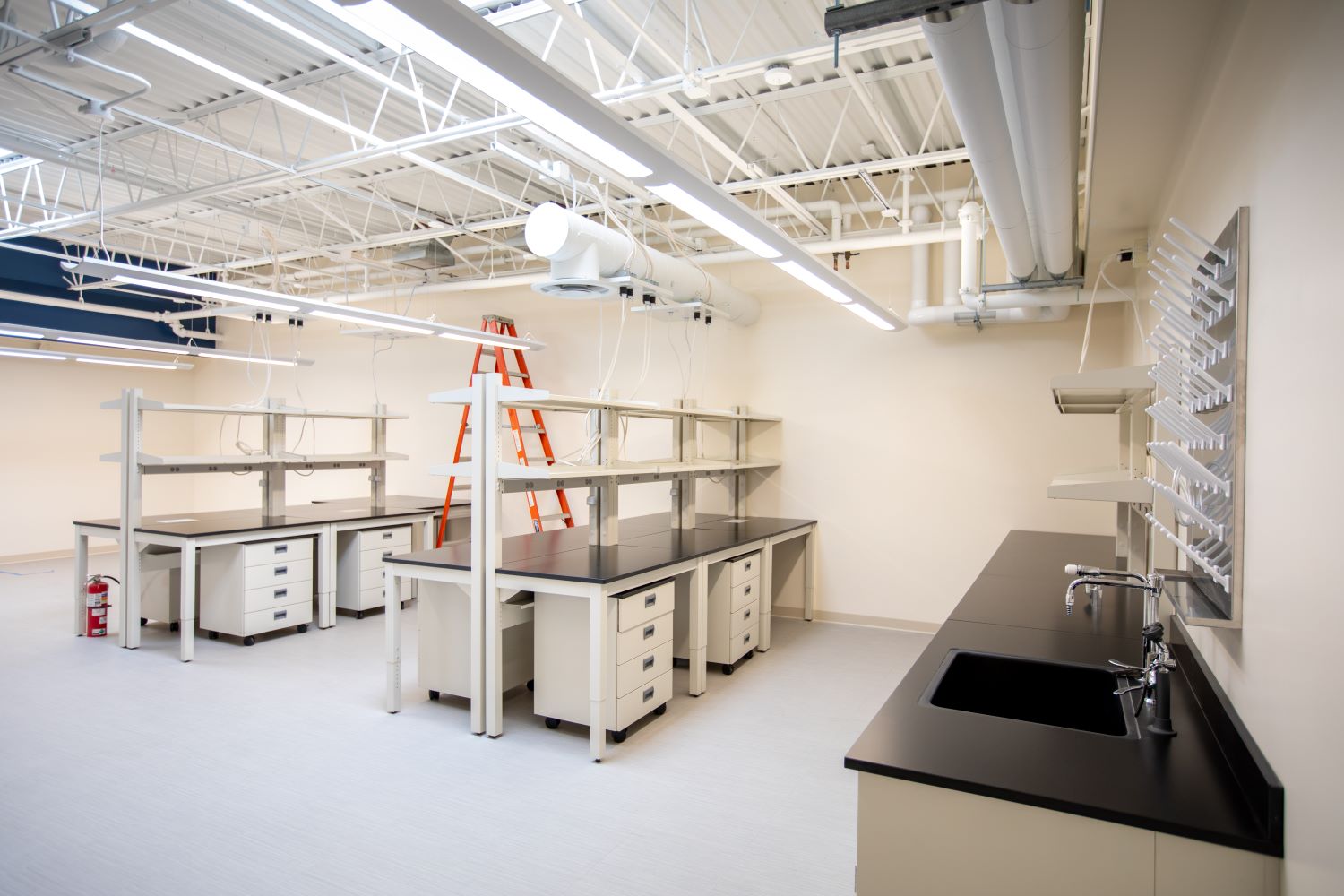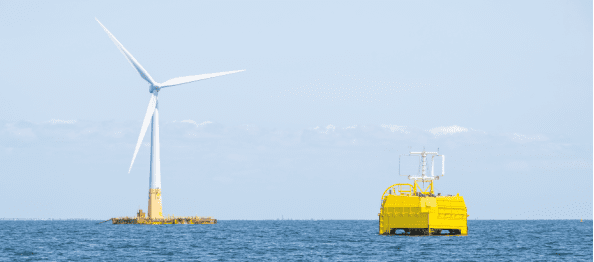February 13, 2024 Project of the Week

Project Name: New York Medical College Basic Sciences Building
Company Name: DIGroup Architecture
Project Location: New York City, New York United States
Project Information/Details: DIGroup Architecture’s (DIG) Healthcare Studio team recently joined New York Medical College to officially open the doors of its newly renovated 18,755-SF Basic Sciences Building (BSB), a space that is not only innovative but collaborative by design. DIG Principal Bob Ryan spearheaded the assignment for which the firm served as Architect of Record. The $6.2M in enhancements to the BSB at New York Medical College, which is a member of Touro University, involved the modernization of an existing research facility with the introduction of flexible shared research cores. This is DIG’s seventh project undertaken with Touro University. In addition to construction of multidisciplinary research space to accommodate up to 12 teams, the new lab features shared instrumentation space and installation of flexible casework systems. Best-in-class equipment includes biosafety cabinets, autoclaves and fume hoods as well as major energy reductions associated with high-efficiency mechanical equipment. “Like many existing academic and life sciences buildings targeted for renovation, the BSB is a highly active facility, so phasing – or the generation of swing space and close coordination of supply and labor procurement – needed to be addressed, tested and verified to assure a ‘near-zero-interruption’ level within the lab itself during this multi-year renovation,” said Ryan, who has more than 30 years’ experience in the healthcare architecture and life sciences field. “In addition to ensuring the seamless work of the laboratory professionals, this approach minimizes the need for costly energy consumption and supply redundancies in the name of delivering the newest best practices for lab design, including modular benches and open layouts,” he explained. While the renovation was launched in 2019, and interrupted by the COVID-19 pandemic, the new BSB is a source of inspiration for new and seasoned users alike. “These professionals are doing vital research in a shared physical space that fosters creativity, communication and a cooperative approach to research, both within and beyond these walls,” said Ryan. “The activities and studies being conducted in this facility produce vital data that informs the entire medical research community and therefore, the physical and mental well-being of a worldwide population.” Furthermore, the BSB’s next-generation design is attracting pharmaceutical and biomedical researchers across the region seeking to pursue their research in the college’s updated space. This objective aligns with New York Medical College’s paradigm for merging the academic and commercial spheres under the same roof. “In addition to building a sustainable research pipeline, the BSB enhances the focus on community outreach – which mirrors DIG’s ‘Architecture for Change’ axiom,” said Ryan.
February 06, 2024 Project of the Week

Project Name: Boarding Platform at Baltimore Penn Station
Company Name: Amtrak
Project Location: Baltimore, Maryland United States
Project Information/Details: Amtrak representatives and stakeholders gathered today with state, local and federal officials for a ribbon cutting to inaugurate a newly constructed boarding platform at Baltimore Penn Station. The new platform is scheduled to begin serving trains this spring. This project is part of Amtrak’s overall redevelopment of Baltimore Penn Station, a $150 million investment to improve customer experience and grow passenger rail. “As we work to redevelop Baltimore Penn Station and enhance the customer experience, this new platform will help ease rail congestion and reduce delays on the Northeast Corridor,” said Amtrak President Roger Harris. “Amtrak ridership continues to grow, and this new platform will help us build future capacity while also improving operational flexibility.” Baltimore Penn Station is the eighth busiest station on the Amtrak network, with more than three million Amtrak and MARC passengers moving through the facility each year. Over the past year, Amtrak ridership increased 29% in Baltimore, surpassing the 24% growth in Amtrak ridership nationwide. Customer Benefits The new boarding platform will provide over 1,000 linear feet of space, including pedestrian pathways and new elevators for ADA accessibility. The project also includes a renovated headhouse, roofing and historical restoration of the columns and canopies for each of the platforms. Operational Benefits This new high-level platform will offer Amtrak more operational flexibility. When other platforms that high-speed trains typically use are already occupied, the new platform will be available for passengers to board or disembark. Looking Ahead This new platform is one of two being built at Baltimore Penn Station. The second platform is scheduled for completion in Fall 2024. These two new high-level platforms will support Amtrak’s expansion of high-speed train service with new Acela trains scheduled to debut later this year. Reactions: Jennifer Mitchell, FRA Deputy Administrator “Renovations and upgrades at Baltimore Penn Station, including the new boarding platform just finished, will modernize a historic hub for Baltimore residents and along the Northeast Corridor, helping to accommodate future ridership growth at one of Amtrak’s busiest stations,” said FRA Deputy Administrator Jennifer Mitchell. “The Federal Railroad Administration is proud to support work at Baltimore Penn Station and beyond as we invest billions from President Biden’s Bipartisan Infrastructure Law to advance projects of national significance in Maryland, like replacing the B&P Tunnel, Bush River Bridge, Gunpowder River Bridge, and Susquehanna River Rail Bridge.” Senator Ben Cardin (D-MD) “It’s an exciting day for the millions of riders who use Baltimore Penn Station as a connection to the greater Eastern Seaboard. The additional platform will provide better, more efficient service in one of the busiest passenger rail stations in the country,” said Senator Cardin. “Amtrak and its partners in Maryland with support from the Biden-Harris Administration’s historic investment in transportation infrastructure is laying the foundation for the future of modern rail in Maryland.” Senator Chris Van Hollen (D-MD) “Our rail system is essential to keeping Marylanders and our economy moving. This new platform will position Penn Station to better accommodate high-speed trains and increase overall capacity for rail service. This is big news for the three million riders – Marylanders and visitors alike – who pass through this critical transit hub each year,” said Senator Van Hollen. Brandon M. Scott, Baltimore Mayor “Penn Station is a gateway to Charm City through which millions of visitors, commuters, and residents arrive, depart, or pass through every single year,” said Baltimore Mayor Brandon M. Scott. “This new platform, and eventually the broader Penn Station renovation, will breathe new life into the storied train station and provide much-needed upgrades for the convenience, safety, and enjoyment of everyone passing through the station. These upgrades are indicative of all of the exciting development and investment flowing into our city and I am thrilled to have these changes be part of the Baltimore renaissance we’re seeing.” Paul J. Wiedefeld, Maryland Transportation Secretary “Amtrak’s new platform at Baltimore Penn Station will help ease congestion along the Northeast corridor, and improve the safety of our customers and workers,” said Maryland Transportation Secretary Paul J. Wiedefeld. “MDOT is proud to work in close collaboration with our state, local and federal partners to reinvigorate Penn Station and the surrounding community.” Holly Arnold, Maryland Transit Administrator “Penn Station is an important hub in MTA’s transit network, providing vital, multi-modal connections,” said Maryland Transit Administrator Holly Arnold. “We appreciate Amtrak’s partnership in improving mobility and access for all.”
January 30, 2024 Project of the Week

Project Name: The Sealhyfe Project
Company Name: Lhyfe
Project Location: Nantes, France
Project Information/Details: Lhyfe, one of the world’s pioneers in the production of green and renewable hydrogen, has announced that the operating results of its offshore hydrogen production pilot platform, Sealhyfe, which returned to dock in November 2023, confirm that the initial objectives have been met and enable another step forward for the company. A world first for offshore hydrogen production The Sealhyfe project, equipped with a 1 MW electrolyser supplied by Plug, aimed to demonstrate that producing hydrogen offshore from renewable energy sources is already a reality. More specifically, the experiment aimed to: - Demonstrate Lhyfe’s ability to operate an industrial-scale production unit in an isolated environment, - Prove the reliability of the electrolysis technology in harsh environmental conditions that are representative of the operating conditions of its future large-scale offshore sites, - Provide a database of operating data that can be used to optimise and make production processes more reliable, and to test the technologies employed with a view to scaling them up to sites with ten times and then 100 times greater capacity. A range of measurement and data collection instruments were installed on board Sealhyfe to ensure precise management and control of all the production unit’s parameters from September 2022 to November 2023, first at the quayside and then at sea. Review of test results and analysis of equipment after 14 months of trials - System responsiveness and versatility: As offshore hydrogen production is particularly relevant for providing services to the electricity grid, Lhyfe repeatedly tested the system’s versatility and responsiveness in a wide range of configurations. The experiment also confirmed the system’s ability to manage the variability of wind power in specific offshore conditions. The electrolysis system was operated as part of the planned research tests, including at maximum production capacity. The performance achieved was as high as on land, confirming the reliability of the installation. - Robustness: Throughout the trial, the production system equipment designed by Lhyfe was tested in extreme conditions for platform movement management, environmental stress, etc. In particular, Sealhyfe was confronted with five significant storms, including Ciaran, which swept along the Atlantic coast in October 2023, with waves over 10 metres high and winds of over 150 kph. A complete analysis of the production system once it was back on land confirmed that all equipment had returned unharmed with its production capacity intact. - Equipment and system optimisation: Throughout the experiment, on-board and remotely-controlled measuring instruments were used to identify ways of optimising the efficiency and reliability of Lhyfe’s production units – including safety systems, electrical architecture, automation, fluid and stock management, etc. – for its other projects. - Remote control: The quayside benchmark testing phase helped to de-risk the project. The vast majority of impacts specific to offshore hydrogen production were identified and reduced. The site was then operated exclusively remotely from Lhyfe's control centre, using supervision and control tools specifically developed by the company. The experiment made it possible to validate the software and algorithms for producing green and renewable hydrogen, and to reduce the number of operations required in the marine environment. In total, Lhyfe carried out fewer than ten maintenance operations and the system was operated for 70% of the operating time. - Regulatory developments: As part of this world first, Lhyfe also worked with the French authorities to define the operating rules for a green hydrogen production unit operating within an urban, industrial and port environment, and also capable of operating in the open sea. Overall, the Sealhyfe project enabled Lhyfe to develop its expertise in handling the constraints associated with offshore industrial deployment, thanks in particular to its experience integrating an isolated, offshore plant on a floating barge at sea. Next steps: HOPE and the ramp-up onshore The results of this experiment are already being incorporated into the HOPE project, which represents the second stage in Lhyfe’s offshore ambitions. This project, which Lhyfe presented with a consortium of nine partners, was selected by the European Commission for a €20 million grant as part of the Clean Hydrogen Partnership, along with an additional €13 million grant from the Belgian government. With HOPE, Lhyfe and its partners are changing scale and aiming to commercialise green hydrogen produced offshore. From 2026, this unprecedentedly large-scale project (10 MW) will be able to produce up to 4 tonnes per day of green hydrogen at sea, which will be exported ashore by pipeline, and then compressed and delivered to customers. The Sealhyfe project will also ensure that the production processes at Lhyfe’s land-based sites are reliable and optimised from the outset, so that they can be ramped up quickly and progressively. Lhyfe’s ambition is to have a production capacity of up to 22 tonnes of green hydrogen per day by the end of 2024 and up to 80 tonnes per day by 2026. Matthieu Guesné, Founder and CEO of Lhyfe said: “The positive results of the Sealhyfe trial and the lessons we have learned from it represent a major new step for Lhyfe. We can now draw on our experience of three onshore sites and one offshore site to design our next green hydrogen production sites. This bolsters our expertise and the confidence of our partners, and supports the entire industry, because Sealhyfe has made offshore hydrogen production a reality”.


